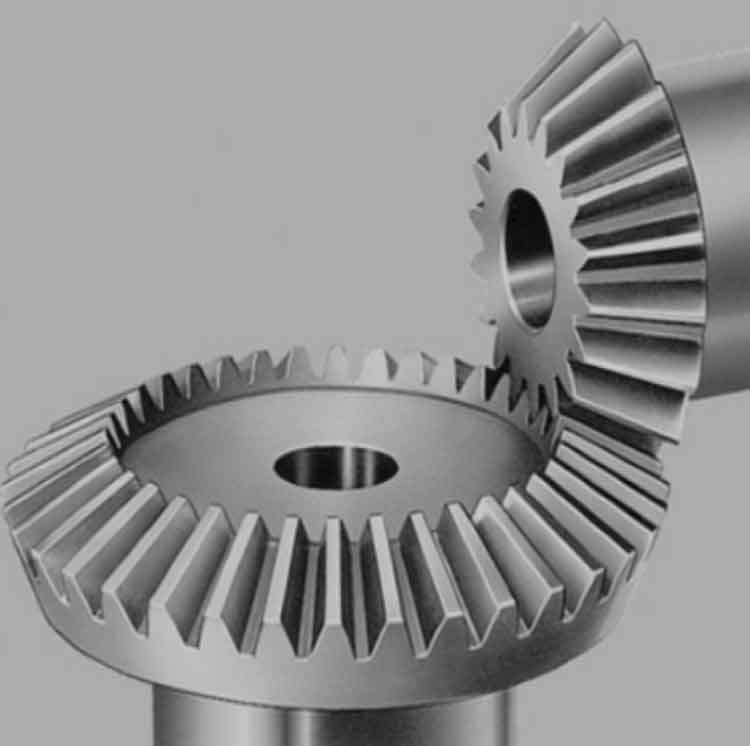
The durability of straight bevel gear, crucial components in many mechanical systems, is significantly influenced by the choice of materials and the application of appropriate heat treatment processes. This guide explores optimal material selections and advanced heat treatment techniques to enhance the longevity and performance of straight bevel gear.
1. Material Selection
High-Strength Alloy Steels:
- AISI 9310: Known for its high hardenability and toughness, AISI 9310 steel is widely used in gear manufacturing. It offers excellent fatigue resistance and is ideal for high-stress applications.
- AISI 8620: This low-alloy steel is noted for its balance of strength and toughness. It’s commonly used for straight bevel gear that require carburizing for enhanced surface hardness.
- AISI 4340: A high-strength alloy steel that provides excellent toughness and fatigue resistance, making it suitable for heavy-duty gear applications.
Carburizing Steels:
- 16MnCr5: This carburizing steel is known for its ability to achieve a hard, wear-resistant surface while maintaining a tough core. It’s widely used in automotive and industrial gear applications.
- 20MnCr5: Similar to 16MnCr5, this steel offers good case hardening properties and is used for straight bevel gear that demand high surface hardness and wear resistance.
Nitriding Steels:
- AISI 4140: This steel is commonly used for nitriding due to its good hardenability and resistance to wear. It’s often used in applications where a hard, wear-resistant surface is critical.
- AISI 4340: In addition to carburizing, AISI 4340 can also be nitrided to enhance surface hardness while maintaining core toughness.
Stainless Steels:
- 17-4 PH: This precipitation-hardening stainless steel offers a good balance of strength, hardness, and corrosion resistance, making it suitable for straight bevel gear operating in corrosive environments.
2. Heat Treatment Processes
Carburizing:
- Process Overview: Carburizing involves introducing carbon into the surface layer of low-carbon steel at high temperatures, followed by quenching to harden the surface.
- Benefits: This process creates a hard, wear-resistant surface while maintaining a tough, ductile core. It enhances the straight bevel gear’s resistance to pitting and wear.
- Applications: Commonly used for automotive straight bevel gear, aerospace components, and industrial machinery.
Nitriding:
- Process Overview: Nitriding introduces nitrogen into the surface of alloy steels at lower temperatures compared to carburizing. The process results in a hard, wear-resistant surface.
- Benefits: Nitriding produces a very hard surface without significant distortion or reduction in core toughness. It also enhances fatigue resistance.
- Applications: Suitable for high-precision gears, aerospace components, and heavy-duty industrial machinery.
Induction Hardening:
- Process Overview: Induction hardening involves heating the straight bevel gear’s surface using an electromagnetic field, followed by rapid cooling (quenching).
- Benefits: This process creates a hard, wear-resistant surface layer while retaining a tough core. It is highly controllable and produces minimal distortion.
- Applications: Common in automotive and heavy machinery applications where localized hardening is required.
Tempering:
- Process Overview: Tempering follows quenching to reduce brittleness and enhance toughness. It involves reheating the quenched straight bevel gear to a temperature below the critical point.
- Benefits: Tempering improves the overall toughness and ductility of the straight bevel gear while maintaining adequate hardness.
- Applications: Used in combination with carburizing and induction hardening to optimize the balance of hardness and toughness.
Cryogenic Treatment:
- Process Overview: Cryogenic treatment involves cooling the straight bevel gear to sub-zero temperatures to transform retained austenite into martensite, followed by tempering.
- Benefits: Enhances wear resistance, dimensional stability, and reduces residual stresses. It complements traditional heat treatment processes.
- Applications: Used for high-precision gears and components requiring enhanced wear resistance and stability.
3. Case Studies and Applications
Automotive Gears:
- Carburized and Hardened: Automotive gears such as those used in transmissions often utilize AISI 8620 steel with carburizing and tempering to achieve a hard surface and tough core. This combination enhances wear resistance and fatigue life.
- Nitrided Components: High-performance automotive applications may use AISI 4140 or 4340 nitrided gears for superior surface hardness and fatigue resistance.
Aerospace Gears:
- Precision Hardened: Aerospace gears made from AISI 9310 steel often undergo carburizing and tempering to ensure high strength, fatigue resistance, and dimensional stability.
- Cryogenically Treated: Critical aerospace components may receive cryogenic treatment in addition to traditional heat treatments to maximize wear resistance and longevity.
Industrial Machinery:
- Induction Hardened: Heavy-duty industrial gears, such as those used in mining equipment, often use induction-hardened AISI 4340 steel to provide a hard, wear-resistant surface while maintaining core toughness.
- Nitrided for Precision: Precision gears in robotics and automation systems frequently utilize nitrided AISI 4140 steel for high surface hardness and minimal distortion.
Conclusion
Enhancing the durability of straight bevel gear through optimal material selection and advanced heat treatment processes is essential for high-performance applications. By choosing the right materials and applying appropriate heat treatments such as carburizing, nitriding, induction hardening, and tempering, manufacturers can produce gears that offer superior wear resistance, toughness, and longevity. These advancements ensure that straight bevel gear can meet the demanding requirements of automotive, aerospace, industrial, and other high-performance applications.
